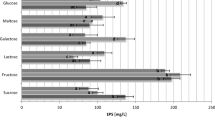Abstract
The ability of six bifidobacterial strains (3 of human origin and 3 isolates from fermented milk products) to utilize glucose, lactose, melezitose, sucrose, raffinose, and stachyose was determined. Dairy-related bifidobacterial strains were identified asBifidobacterium animalis (2 strains) or asB. pseudolongum (1 strain). Human strains includedB. longum (2 strains) andB. breve (1 strain). All strains fermented lactose, sucrose, raffinose, and stachyose. Melezitose was utilized only byB. longum. B. pseudolongum did not ferment either glucose or melezitose. All isolates had a higher specific growth rate on raffinose and stachyose than on glucose. Dairy strains grew slowly on glucose compared to human strains.
Similar content being viewed by others
References
Blavati B., Sgorbati B., Scardovi V.: The genusBifidobacterium, pp. 816–833 in A. Barlows, H.G. Trüper, M. Dworkin, W. Harder (Eds):The Procaryotes. A Handbook on the Biology of Bacteria, Vol. 1. Springer-Verlag, New York 1992.
Bonaparte C.: Selective isolation and taxonomic position of bifidobacteria isolated from commercial fermented dairy products in central Europe, p. 199 inPhD Thesis. Berlin Technical University; Schüling, Münster (Germany) 1997.
Durieux A., Fougnies C., Jacobs H., Simon J.P.: Metabolism of chicory fructooligosaccharides by bifidobacteria.Biotechnol. Lett.23, 1523–1527 (2001).
Fuller R.: Probiotics in man and animals.J. Appl. Bacteriol.66, 365–378 (1989).
Gavini F., Pourcher A.M., Neut C., Monget D., Romond C., Oger C., Izard D.: Phenotypic differentation of bifidobacteria of human and animal origins.Internat. J. Syst. Bacteriol.41, 548–557 (1991).
Gibson G.R., Roberfroid M.B.: Dietary modulation of the human colonic microbiota—introducing the concept of prebiotics.J. Nutr.125, 1401–1412 (1995).
Gibson G.R., Wang X.: Bifidogenic properties of different types of fructo-oligosaccharides.Food Microbiol.11, 491–498 (1994).
Gibson G.R., Beatty E.R., Wang X., Cummings J.H.: Selective stimulation of bifidobacteria in the human colon by oligofructose and inulin.Gastroenterology108, 975–982 (1995).
Gibson G.R., Saaverda J.M., Macfarlane S., Macfarlane G.T.: Probiotics and intestinal infections, pp. 10–31 in R. Fuller (Ed.):Probiotics 2: Application and Practical Aspects. Chapman and Hall, London 1997.
Hopkins M.J., Cummings J.H., Macfarlane G.T.: Inter-species differences in maximum specific growth rates and cell yields of bifidobacteria cultured on oligosaccharides and other simple carbohydrate sources.J. Appl. Microbiol.85, 381–386 (1998).
Mitsuoka T.: Taxonomy and ecology of bifidobacteria.Bifidobacterium Microflora3, 11–28 (1984).
Mitsuoka T.: The human gastrointestinal tract, pp. 69–114 in B.J.B. Wood (Ed.):The Lactic Acid Bacteria in Health and Disease. Elsevier Applied Science, London 1992.
Orban J.I., Patterson J.A.: Modification of the phosphoketolase assay for rapid identification of bifidobacteria.J. Microbiol. Meth.40, 221–224 (2000).
Rada V., Koc J.: The use of mupirocin for selective enumeration of bifidobacteria in fermented milk products.Milchwissenshaft55, 65–67 (2000).
Rada V., Dušková D., Marounek M., Petr J.: Enrichment of bifidobacteria in the hen caeca by dietary inulin.Folia Microbiol.46, 73–75 (2001).
Roberfroid M.B., Van Loo J.A.E., Gibson G.R.: The bifidogenic nature of chicory inulin and its hydrolysis products.J. Nutr.128, 11–19 (1998).
Rogosa M.: GenusBifidobacterium, pp. 1418–1434 in R.E. Buchanan, N.E. Gibbons (Eds):Bergey's Manual of Systematic Bacteriology, Vol. 2. Williams and Wilkins, Baltimore 1974.
Roy D., Mainville I., Mondou F.: Bifidobacteria and their role in yoghurt-related products.Microecol. Ther.26, 167–180 (1997).
Author information
Authors and Affiliations
Rights and permissions
About this article
Cite this article
Rada, V., Bartoňová, J. & Vlková, E. Specific growth rate of bifidobacteria cultured on different sugars. Folia Microbiol 47, 477–480 (2002). https://doi.org/10.1007/BF02818784
Received:
Revised:
Issue Date:
DOI: https://doi.org/10.1007/BF02818784




